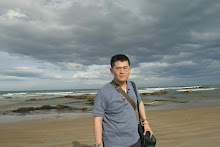Magic Beach, revealed only at low tide along the sweeping shores of Cape Woolamai on Phillip Island, is a place where the natural and the personal converge in quiet wonder. When the ocean withdraws, the sea floor unveils a scatter of ancient rocks, their surfaces carved and smoothed over millennia by waves and wind. These formations are the remnants of a powerful volcanic past, for Cape Woolamai itself is born of basaltic flows and granite intrusions that date back millions of years, their rugged cliffs now standing sentinel over Bass Strait. Long before European arrival, this coastline formed part of the lands of the Bunurong people, who knew its rhythms of tide, bird, and season. Today, it remains both a sanctuary for migratory seabirds and a dramatic landscape that draws the eye and stirs the imagination.
It was here, during the pandemic year when Melbourne lay under lockdown, that I came alone with my newly acquired Sony A7RIV, predecessor of the A7RV, eager to explore its capabilities. Magic Beach seemed an apt stage for such an experiment. I found myself entranced by the interplay of light and shadow across tide pools and rocks, using HDR techniques I had never attempted with my earlier Panasonic or Canon cameras. The solitude of that moment—an island shore, a receding tide, the silence broken only by surf—transformed the practice of photography into something almost meditative. In that fleeting communion, I glimpsed both the deep history of Cape Woolamai and the personal magic of discovery, as if the land itself conspired with my lens to etch memory into image.
Sony A7RIV
FE 16-35mm f2.8 GM
Linking Skywatch Friday


